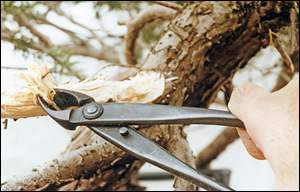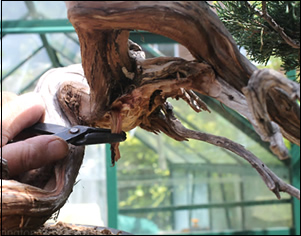In this instance, it is important to be selective as to where on the trunk the shari should be. Before removing the bark, use a marker pen or piece of chalk to outline the area to be carved. Ensure that when carving, the process does not impair the flow of nutrients to those branches in proximity to the shari.
The full correct term is sharamiki, meaning deadwood. Do not overdo this; it is a job for the experienced and those knowledgeable enough horticulturally not to ‘ringbark’ accidentally and consequently kill the tree. Experiment with very small areas of stripped and hollowed trunk; if you are successful, you can try more later.
- Choose the right spot on the trunk for a shari – one that not only looks good but also does not cut off supplies of nutrients to branches higher on the tree. Before you start removing bark, draw the desired shape of the shari on the trunk with chalk or a pen.
- Start by taking just a narrow strip of bark; you can widen it in stages.
- Outline the shape and cut through the bark with a sharp knife, tearing the bark down using jin pliers.
- Hollow out the defined shape with carving tools to the depth you initially feel safe doing; you can deepen it later.
- Bleach the area with lime sulphur as with the jins – as well as providing an ageing effect, it also acts to protect against infection..
In the case of both jins and sharis, attaining a natural appearance of the dead wood is important. This can be achieved by tearing away fibres from the wood i.e. pulling away fine strips of wood along the length of the grain to create a natural effect. When fibres are pulled along the length of a branch or trunk, the pulled-fibres will create lines (or depressions) – see images.
Sometimes, the degree of carving required to achieve as good a deadwood effect as possible will necessitate the use of more complex tools and equipment. This especially applies to larger specimens, including collected material such as pines and junipers.

